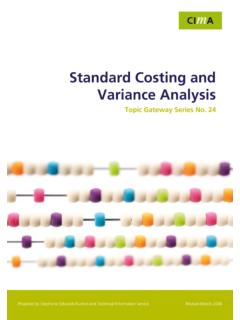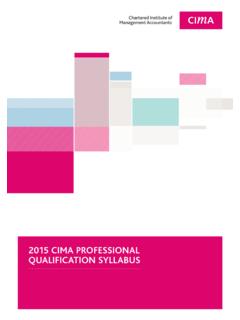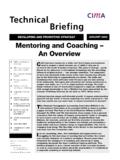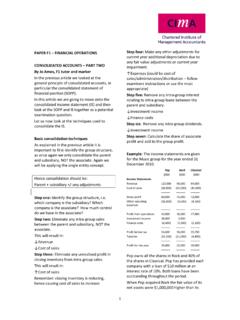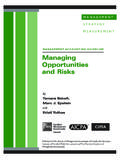Transcription of Corporate Governance Topic Gateway - CIMA
1 Topic Gateway Series Corporate Governance Corporate Governance Topic Gateway Series No. 5. 1. Prepared by Gillian Lees and Technical Information Services Revised July 2008. Topic Gateway Series Corporate Governance About Topic Gateways Topic Gateways are intended as a refresher or introduction to topics of interest to CIMA members. They include a basic definition, a brief overview and a fuller explanation of practical application. Finally they signpost some further resources for detailed understanding and research. Topic Gateways are available electronically to CIMA Members only in the CPD.
2 Centre on the CIMA website, along with a number of electronic resources. About the Technical Information Service CIMA supports its members and students with its Technical Information Service (TIS) for their work and CPD needs. Our information specialists and accounting specialists work closely together to identify or create authoritative resources to help members resolve their work related information needs. Additionally, our accounting specialists can help CIMA. members and students with the interpretation of guidance on financial reporting, financial management and performance management, as defined in the CIMA.
3 Official Terminology 2005 edition. CIMA members and students should sign into My CIMA to access these services and resources. The Chartered Institute of Management Accountants 26 Chapter Street London SW1P 4NP. United Kingdom T. +44 (0)20 8849 2259. F. +44 (0)20 8849 2468. E. 2. Topic Gateway Series Corporate Governance Corporate Governance - updated Definition 'The system by which companies and other entities are directed and controlled. The boards of directors are responsible for the Governance of their companies and other entities.
4 The shareholders' role in Governance is to appoint the directors and the auditors, and to satisfy themselves that an appropriate Governance structure is in place. The responsibilities of the board include setting the company's (or entity's) strategic aims, providing the leadership to put them into effect, supervising the management of the company (or entity) and reporting to shareholders on their stewardship. The board's actions are subject to laws, regulations and the shareholders in general meeting.'. CIMA Official Terminology, 2005.
5 'The three principles underpinning Corporate Governance are enterprise, transparency and accountability.'. Charkham, 2005. Concept Corporate Governance typically covers the following areas: the board of directors its composition and role, appointments, performance executive remuneration financial reporting and internal control including mechanisms such as audit committees to ensure that the board fulfils its responsibilities in these areas relations with shareholders, plus shareholder rights and responsibilities. Context In the current syllabus, CIMA students will learn and may be examined on this Topic in paper P5 Integrated Management and P3 Management Accounting Risk and Control Strategy of the professional qualification.
6 Study systems for these papers are available from CIMA Publishing. Available from: [Accessed 7 July 2008]. 3. Topic Gateway Series Corporate Governance Overview The first Corporate Governance report and code of best practice is considered to be the UK Cadbury Report in 1992, which was produced in response to a number of unexpected Corporate collapses. In effect, it launched Corporate Governance as a major issue in its own right. Since the publication of Cadbury, many countries have also produced reports on Corporate Governance . In many cases, these have been accompanied by codes of best practice, although some countries tend towards a statutory approach to Corporate Governance regulation.
7 A number of international organisations have also launched guidelines and/or initiatives on Corporate Governance , including the OECD and the European Union (EU). In recent years, Corporate collapses such as Enron, WorldCom and Parmalat have provoked further reviews of Corporate Governance across the world. These resulted in the US Sarbanes-Oxley Act 2002, the 2008 UK Combined Code on Corporate Governance and the EU Action Plan on company law and Corporate Governance . Relationship with company law A sound system of Corporate Governance is dependent on a robust framework of company law.
8 In this sense, they are complementary. As a rough rule of thumb, Corporate Governance tends to deal with issues that cannot be dealt with easily through legislation. This would include the balance of boards of directors between executive and non-executive directors. However, the Sarbanes-Oxley Act is an example of a statutory approach. In the UK certain aspects of executive remuneration are now covered by legislation. The advantage of a non-statutory approach is that codes of best practice are more flexible and can be updated more quickly.
9 In the UK, for example, the code of best practice has been revised a number of times since 1992. A key characteristic of the best practice approach is the principle of 'comply or explain'. This normally means that where a company does not comply, it must provide an explanation as to why it has not complied with the regulation. This approach recognises that there will be circumstances where it is in the interests of companies and shareholders to adopt different practices from those set out in the code. It is for companies to provide adequate explanations and for investors to consider them carefully on their own merits.
10 Although 'comply or explain' has been widely accepted in principle, there have been cases where 4. Topic Gateway Series Corporate Governance investors have not proved willing to fulfil their side of the bargain. In practice The four components of Corporate Governance in practice Corporate Governance covers four components. Key issues relating to each component are listed below: Boards of directors The role of the board. Frequency of meetings. Whether the role of chairman and chief executive should be split. The overall size of the board.
